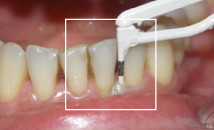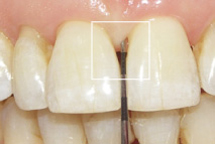What is bacterial plaque?
It is a sticky and adhesive white substance that deposits on the teeth.
Formed by bacteria and their product that take nutrients from our food to produce acids that damage tooth enamel and that take nutrients from our tissues, like the gum, to produce toxins that damage them even more.
It can only be removed with a toothbrush and interdental elements, its accumulation brings: cavities, gum inflammation and calculus, which is the mineralisation of the bacterial plaque and must be removed only at the office due to its extreme hardness.
What is periodontal disease?
The disease of the periodontium known as pyorrhea, paradentosis or gum disease is a multifactorial disease, initiated and maintained by bacteria that normally live in the mouth, and that inhabit the tooth surface, above and below the gums, forming the bacterial plaque and calculus.
Its constant accumulation allows the continuity of toxic substances that damage the tissues that support the teeth or periodontal tissue, represented by the gum, the periodontium and the bone.
There are two inflammatory stages. gingivitis and periodontitis. Gingivitis is just the inflammation of the gum. Periodontitis is the inflammation that extends to all structures, gum, bone and periodontium, according to that extension it can be mild, moderate or severe. With the periodontal probe which measures 12 mm. the diagnosis is done considering that the normal separation normal between the gum and the tooth is 3 mm. and increases as the pathology progresses.
Damaged gum.
The probe enters 5 mm.
Damaged gum.
The probe enters 7 mm.
Calculus and plaque are present. The gum recedes.
Periodontal Treatment
The treatment involves full-mouth disinfection, through the thorough cleaning of root surfaces (below the gumline). This is carried out at the dentist’s office with ultrasound, and manual instruments such as curettes and laser. Then the patient should keep teeth healthy over time with the proper use of the toothbrush and interproximal cleaning elements, according to each clinical case.
HEALTHY GUM: Despite gingival recession, gums are healthy. The probe enters just 2 mm.
Can this lead to other health problems?
Bacteria together with their products and also the molecules the patient produces during the infection enter the blood stream and cause side-effects from afar.
Periodontal disease is contraindicated in patients with cardiovascular disease.
There is an increased atheromatous plaque formation.
During pregnancy, hormones work as nutrients for bacteria: Therefore, the disease gets worse. Bacteria and their products can lead to premature birth (less than 37th week of pregnancy) and to low birthweight babies (less than 2.5 kilos).
Periodontal disease is usually considered a complication of diabetes since gum disease may increase the risk for diabetes. In diabetic patients, who are more susceptible to contracting infections, it is very important to stop the progression of gum disease to improve diabetes and reduce insulin levels.
In smokers, there is an increased progression of the attachment loss of periodontal tissues, i.e. the tissues that surround and support the teeth.







